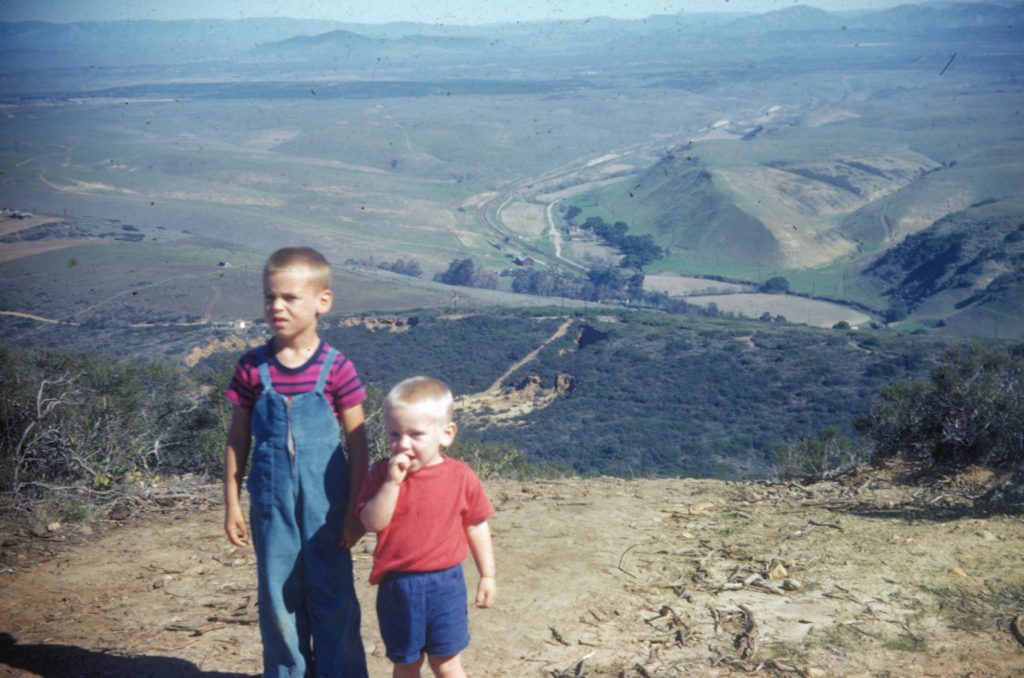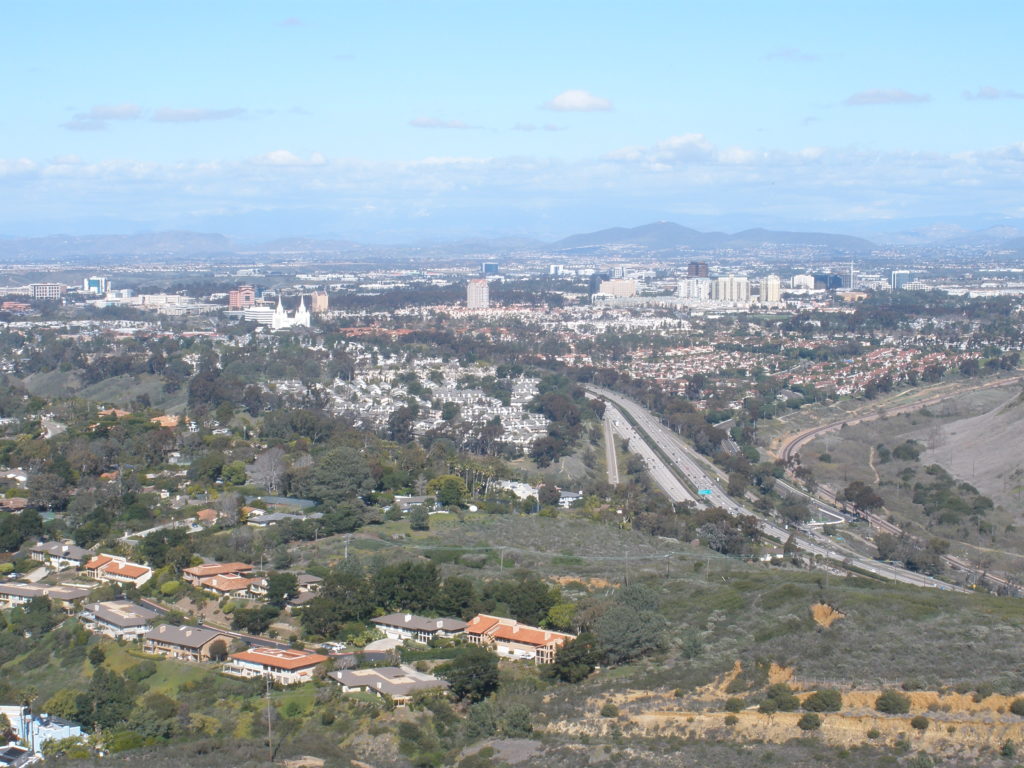Mt. Soledad, which rises abruptly to the east of La Jolla and descends more gradually south to Pacific Beach, is the highest point in the city of San Diego. At 822 feet above sea level and within about a mile of the Pacific Ocean it is also said to be the highest coastal elevation in California. With an unobstructed view from horizon to horizon it has long been popular as an observation point. In 1905, the San Diego Union’s annual New Year’s Day report from La Jolla noted that Old Soledad rose majestically, keeping watch over the town nestling at its feet, and that the half-hour’s stiff climb to the old signal station at the top was amply repaid by the panorama you would find yourself the center of; San Diego, Coronado and grand old Point Loma, the broad expanse of Rose Canyon, the mountains, and the illimitable expanse of ocean, Clemente and Catalina showing clear and distinct in the distance. If you were also one of those favored mortals privileged to see one of La Jolla’s gorgeous sunsets from that vantage point, you would return a ‘better and a wiser man for what it has been granted you to look upon’ (the ‘old signal station’ was apparently the survey station established on the summit in 1899 by A. T. Mossman of the U. S. Coast and Geodetic Survey).
In April 1908 the Union recommended the summit of Mt. Soledad as a rare natural observatory from which to get a first glimpse of the Great White Fleet, the armada of U. S. battleships that was making its first United States port call at San Diego after sailing around Cape Horn on a round-the-world voyage. The fleet’s arrival on April 13 drew the largest crowds ever seen in San Diego at the time, but La Jolla residents and visitors who did not wish to go to San Diego could view the coming of the fleet from the mountain top. Other sights were also best seen from the mountain; in April 1910 the Union reported that a comet party made its adventurous way up Mt. Soledad to gain in the clear upper air an unobstructed view of the celestial wanderer (Halley’s comet).
To make the way up Mt. Soledad a little less adventurous, in 1913 A. H. Frost, president of the San Diego Beach Company, which owned much of Pacific Beach, and Clark Bailey, a La Jolla capitalist, built a four-mile-long road from the foothills above Pacific Beach to the summit of Mt. Soledad. The Evening Tribune reported that the route started near the Pacific Beach reservoir and by an easy grade followed the contour of the hills, providing a splendid view of mountains, sea and islands. The road was improved and realigned in 1916 to connect it to the end of Lamont Street in Pacific Beach and its completion was celebrated in April of that year when 60 members of the San Diego Floral Association guided by Kate Sessions drove to the top in twelve automobiles and planted five Torrey Pines and three Mount Diablo big cone pines, grown from seed and donated by Miss Sessions. The ‘flower lovers’ declared that the view was well worth the trip to the top.

Mt. Soledad lies within the pueblo lands of San Diego and in June 1916 La Jolla residents petitioned the city council to set aside the south 120 acres of Pueblo Lot 1265, described as the summit of Mt. Soledad, for a public park (actually, the highest point in Pueblo Lot 1265 is 811 feet; the 822-foot summit of Mt. Soledad is about half a mile west, within Pueblo Lot 1264). The council voted unanimously to approve the petition and the south 120 acres of Pueblo Lot 1265, ‘commanding a view of the ocean, mountains and of the entire city’, became a city park in July 1916.

In 1926 the chambers of commerce of La Jolla, Mission Beach and ‘San Diego Beach’ (the would-be name for a hoped-for redevelopment of Pacific Beach) formed the North Shores Civic League to promote their communities. The League noted that a neglected feature of the North Shores area was the wonderful scenic panorama that could be observed from Mt. Soledad and they recommended that the ‘fair trail’ from Pacific Beach to the summit should be developed into an auto road. According to the San Diego Union, citizens of La Jolla and Pacific Beach assembled with shovels and rakes and aided by scrapers furnished by the city performed wonders in turning the trail into a serviceable dirt road by which autos could reach the summit in high gear. The completion of this ‘new road from the south’ was the occasion for a celebration at the summit in which Dr. H. K. W. Kumm, ‘traveler, writer and lecturer’ (and Pacific Beach resident), declared that while such sights as the Grand Canyon and Victoria Falls might be more awe-inspiring, they could hardly be considered more beautiful than the view from Mt. Soledad (although the San Diego Union admitted that the day was a trifle hazy and the usual clear view of the mountains was obscured). Kate Sessions planted three more pine trees and cadets from the Army and Navy Academy in Pacific Beach were in charge of a military ceremony and flag raising.
For more than 80 years now the top of Mt. Soledad has been marked by a large cross, standing over 30 feet tall. There are reports that a redwood cross was dragged up the mountain with a good deal of labor and patience and that worshipers held Easter services beneath it in 1913, but if so it was probably not at the same location as the current cross. The San Diego Union announced in 1914 that the churches of La Jolla would hold a joint sunrise Easter service at the reservoir, presumably meaning what is now the Exchange Place reservoir in La Jolla, and in the early 1920s the churches again joined to conduct Easter sunrise services near the clubhouse of the La Jolla golf course. The redwood cross was reportedly stolen in 1922, but if this cross ever existed it was probably located at one of these sites on the lower slopes of Mt. Soledad.

By 1925 the Union reported that Easter sunrise services had become an annual institution in La Jolla and attracted increasingly large crowds each year. In 1929 plans were announced for the sunrise service to be held by the pastors of North Shore protestant churches at a ‘scenic point on Soledad Mountain’. According to the Tribune, the Pacific Beach chamber of commerce had cleared the ground on Mt. Soledad and would clear the road up the mountain from Pacific Beach. The PB Boy Scout troop had agreed to take a hiking trip from the head of Lamont Street to the scenic point a few days before Easter and throw any stray rocks and pebbles out of the road. Representatives from La Jolla were also expected to clear two other routes from La Jolla, opening up three avenues of traffic to help avoid congestion. A special committee was appointed to supervise the erection of a cross and platform. The ‘scenic point’ was apparently the city park on Mt. Soledad, which was to become the site of annual Easter sunrise services in the coming decades.

One thousand residents of the North Shore district attended the first Easter sunrise service at the park on Mt. Soledad in 1929 and the Evening Tribune reported that a two-mile chain of torches along the highways leading up to the mountain had been arranged in the form of a gigantic cross. An Easter sunrise service was also held on Mt. Soledad in 1930, attended by 500, but the custom then apparently lapsed until being revived in 1934 under the auspices of the Pacific Beach chamber of commerce. In March 1934, just a few days before Easter, the city built a ‘frame stucco cross’ in the city park and on Easter morning hundreds of residents gathered before the cross as Army and Navy Academy buglers heralded the beginning of the service.
Easter sunrise services at the cross on Mt. Soledad became an annual event but just before Easter in March 1952 the San Diego Union reported that the weather-scarred old cross, pitted with BB shot launched at it by mischievous youngsters and buffeted through the years by the elements, had been toppled by wind and shattered beyond reasonable repair. The Union noted that city employees had patched, stuccoed and strung framework over chicken-wire fabric to construct the 30-foot cross and that throughout its existence it had withstood all influences except one: an act of God.
Plans to replace the stucco cross began immediately and contributions were accepted at the 1952 Easter sunrise service. In May 1952 the Mt. Soledad Memorial Committee announced that plans were nearly completed for a ‘lasting cross’ atop ‘historic Mt. Soledad’. The proposal included a new cross of reinforced concrete as well as a paved assembly area large enough for several thousand persons, a parking area for 800 or more automobiles and about 2000 feet of new highway.
In 1953 the 32nd annual Easter sunrise service was held at the site of the old cross. A temporary cross was erected and an offering taken to go towards rebuilding the cross. By September the Memorial Committee had obtained sufficient funds for building and maintenance of the cross and grounds, and announced that construction would begin as soon as city approval was gained. Actual construction involved pouring twenty tons of concrete into forms laid out on the ground and allowing it to cure for 60 days. However, when a pair of cranes attempted to raise the cross into position in February 1954 its weight produced ‘certain stresses that it wouldn’t take’ and it cracked in two places just below the horizontal section of the cross. Contractors, engineers and architects studied the problem and decided they could remove and recast the cracked section and still have the cross in place before Easter. In fact, the cross was repaired and raised in time to be dedicated on Easter Sunday, 1954. The paved assembly area and parking lot for thousands of people originally proposed by the Memorial Committee was never built.

The cross built within the city park on Mt. Soledad in 1934 and rebuilt in 1954 was specifically intended for Easter sunrise services, and for years maps identified the site as the Mt. Soledad Easter Cross. However, in the 1980s, the presence of a prominent religious symbol on public property in apparent violation of the constitution led to lawsuits, and at one point a court ordered the cross to be removed. Instead, the constitutional issue was resolved by returning the land under the cross to private ownership. The Easter cross became the Mt. Soledad Veterans Memorial Cross, a tribute to armed forces servicemen and women, and in 2006 the property was taken over by the U. S. Department of Defense. After an act of congress in 2014 allowed it to be transferred to private ownership it was sold to the Mount Soledad Memorial Association in 2015. In September 2016 the courts ruled that since the cross no longer stood on public property the case for its removal was moot.
The legal battles may now be over, the cross on Mt. Soledad is still standing, and the panorama a visitor may find themselves the center of amply repays the few minutes it now takes to drive to it.
